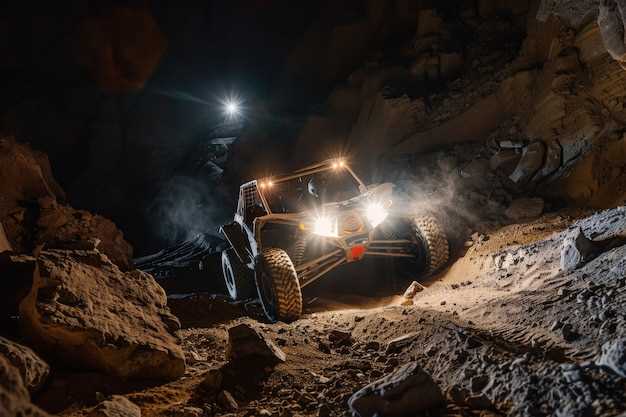
Embarking on an off-road adventure requires not only a robust vehicle, but also dependable gear to ensure safety and visibility. Among the most critical elements of this gear are bar lights, which enhance visibility during nighttime excursions and challenging weather conditions. Upgrading your trail lighting can make a significant difference, transforming your adventures into safer experiences while allowing you to tackle rugged terrains with confidence.
Modern off-road equipment demands advanced lighting solutions that pair seamlessly with your vehicle. Adequate illumination provided by high-quality lights not only enhances your ability to navigate tricky trails but also makes you more visible to other drivers and off-road enthusiasts. When exploring remote areas, proper visibility can be a decisive factor in preventing accidents and ensuring that every adventure is as enjoyable as it is thrilling.
In this article, we will delve into the various types of lighting options available for off-road use and discuss how visibility upgrades can elevate your outdoor experiences. Whether you’re traversing through dense forests or navigating rocky terrains, the right lighting transforms your gear into adventure-ready equipment, allowing you to embrace the wild with confidence.
Choosing the Right LED Bar for Off-Road Adventures

When it comes to off-road adventures, having the right lighting solution is essential for safety and visibility. LED light bars are a popular choice among enthusiasts due to their durability, brightness, and efficiency. Here are some key factors to consider when selecting the ideal LED bar for your off-road vehicle:
- Brightness: Look for LED bars with high lumens output to ensure maximum visibility during night rides. Generally, a higher lumen count equates to better light quality.
- Beam Pattern: Different beam patterns serve various purposes. Choose between flood, spot, or combo beams depending on how you plan to use the lights. Flood beams are great for illuminating broad areas, while spot beams focus on long-distance visibility.
- Size: The size of the LED bar should match your vehicle. Ensure it fits securely on your mounting location without obstructing airflow or affecting other components.
- Durability and Construction: Off-road environments can be rugged. Opt for LED bars that feature waterproof, dustproof, and shock-resistant properties to withstand harsh conditions.
- Wattage and Power Consumption: Consider the wattage of the LED bar and its power consumption. Ensure your vehicle’s electrical system can handle the additional load without compromising performance.
- Mounting Options: Evaluate the ease of installation. Some LED bars come with adjustable mounting brackets, enabling you to position them for optimal lighting.
By taking these factors into account, you can choose an LED bar that not only enhances visibility but also elevates your off-road experience. Properly installed and utilized, these lights can provide a significant advantage during your adventures.
Mounting Options for Optimal Light Distribution
When it comes to maximizing visibility during outdoor adventures, the mounting options for LED lights play a crucial role in achieving optimal light distribution. Proper mounting not only enhances illumination but also improves safety and overall usability of adventure gear. Understanding the various installation methods can help adventurers select the best setup for their needs.
One popular mounting option is the use of light bars, which can be affixed to the front of vehicles, bicycles, or even backpacks. Light bars provide an expansive beam pattern, illuminating a wide area ahead and ensuring that obstacles are visible from a distance. The height and angle at which a light bar is mounted is essential; too high can lead to a reduced focal area, while too low might cause glare and reduce visibility.
Another effective mounting strategy involves adjustable brackets. These allow users to fine-tune the direction of LED lights to achieve the most effective beam angle. This versatility is particularly beneficial for varying terrain and changing environmental conditions. The ability to pivot lights can significantly enhance peripheral vision, offering better awareness of surroundings.
In addition to standard brackets, magnetic mounts offer a flexible solution for temporary setups or situations requiring quick adjustments. These allow for rapid relocation of lights, ensuring maximum efficiency on the trail without the need for permanent fixtures. However, one must consider the strength of the magnet and the stability of the surface to prevent any accidental dislodgments during movement.
User preferences also dictate the choice of mounting options. For instance, headlamps provide hands-free lighting and can be easily mounted to helmets or worn directly on the head. This provides a focused beam right where it’s needed, allowing for detailed visibility without the need to adjust external lights.
Overall, the key to effective light distribution lies in understanding the mounting options available. By selecting the right combination of LED lights and bars, along with strategic positioning, adventurers can significantly enhance their experience in the great outdoors. Proper mounting not only optimizes light output but also contributes to a safer and more enjoyable adventure.
Power Supply Considerations for Off-Road Lighting Systems
When upgrading off-road lighting systems, it is essential to consider the power supply that will effectively support the lights installed on your vehicle. Proper power management ensures optimal performance, safety, and longevity of the lighting system. Here are crucial factors to consider:
1. Voltage Requirements: Most off-road lights operate on either 12V or 24V systems. It is vital to match the voltage of the lights to your vehicle’s electrical system to avoid malfunctions.
2. Wattage Rating: Each light will have a specified wattage. Calculate the total wattage of all lights being installed to ensure that the power supply can handle the load without overloading the system.
3. Wiring and Circuitry: Use high-quality wiring that can handle the combined wattage of your lighting setup. Thicker wires reduce resistance and heat buildup, which can prevent power loss and potential fire hazards.
4. Power Distribution: Consider using a dedicated power distribution bar for wiring. This method simplifies connections, improves organization, and enhances safety by minimizing the risk of shorts and overloads.
5. Fuse Protection: Implement fuses rated appropriately for the total wattage. Fuses protect the electrical system by breaking the circuit in case of an overload, thus preventing damage to components.
6. Battery Capacity: A robust battery is essential to support off-road lighting during extensive use, particularly in remote areas. Assess the battery’s amp-hour rating to ensure it can sustain the power demand throughout your adventure.
| Component | Consideration |
|---|---|
| Voltage | Match with vehicle (12V or 24V) |
| Wattage | Calculate total wattage; avoid overload |
| Wiring | Use thick, high-quality wires to reduce resistance |
| Power Distribution | Consider a distribution bar for easier management |
| Fuse | Implement fuses rated for total wattage capacity |
| Battery | Ensure sufficient capacity for extended use |
Understanding these power supply considerations will help ensure that your off-road lights operate effectively and safely, enhancing your visibility and enjoyment during any adventure.
Weatherproofing and Durability for Trail Lighting Gear

When venturing off-road, having reliable trail lighting gear is essential for ensuring safety and visibility. The harsh conditions encountered during outdoor adventures demand that these devices be designed with weatherproofing features to withstand rain, snow, and dust. Effective weather sealing prevents moisture ingress, protecting sensitive electronic components from corrosion and failure.
LED lights are increasingly becoming the standard for trail lighting due to their energy efficiency and longevity. However, even the most advanced LED systems can be rendered useless if not adequately protected. Selecting lights that feature robust housings made from durable materials such as aluminum or high-quality plastics can significantly enhance the lifespan of the gear. These materials not only provide resistance to impacts and abrasions but also contribute to the overall reduction of weight, making them ideal for adventurous trips.
Apart from housing materials, consider choosing lights that incorporate impact-resistant lenses. Polycarbonate lenses are particularly effective in preventing breakage while maintaining excellent light transmission. Furthermore, many modern trail lights come with additional features like rubberized edges to absorb shocks and vibrations, increasing their durability during rugged use.
In addition to the structural integrity, it is essential to assess the ingress protection (IP) rating of the lights. An IP67 rating, for example, signifies that the device is dust-tight and can withstand immersion in water up to a certain depth. Such specifications ensure that the lighting remains operational in various environmental conditions, providing peace of mind for the user.
Ultimately, investing in weatherproof and durable lighting gear is crucial for any adventurer looking to enhance visibility and safety on trail excursions. By selecting high-quality off-road lights with advanced weatherproofing features, adventurers can ensure that they are well-prepared for any challenge that lies ahead.
Regulations and Legal Considerations for Off-Road Lights
When outfitting your adventure-ready gear with off-road lights, it is essential to consider the regulations and legal aspects governing their use. In many jurisdictions, there are specific laws that dictate the type, placement, and brightness of off-road lights, particularly LED bars. Compliance with these regulations is crucial to ensure safety for both the vehicle operator and other road users.
One primary consideration is the permissible intensity of the lights. While LED bars can provide exceptional visibility, many areas restrict their brightness to prevent blinding oncoming traffic. It’s vital to check local laws to determine acceptable lumen output and avoid potential fines or safety issues.
Additionally, the positioning of off-road lights can affect legality. Many regions require that lights be mounted only in specific locations on a vehicle to avoid interfering with standard vehicle operations. Proper positioning not only aids in compliance but also optimizes visibility during off-road adventures.
The color of the lights can also be a legal concern. While white lights are commonly acceptable, blue and red lights are often restricted to emergency vehicles. Thus, using LED lights in these colors could lead to legal repercussions.
Finally, some areas may have regulations regarding the use of off-road lights on public roads. If you transport your vehicle on highways or city streets, ensure that your lights comply with road-specific laws. Failure to adhere to these provisions may result in penalties or equipment removal.
Maintenance Tips for Longevity of LED Lighting Solutions
To ensure the longevity and optimal performance of your LED lighting solutions, particularly those used in adventure off-road gear, regular maintenance is essential. Proper care not only extends the lifespan of the lights but also enhances visibility during your off-road excursions.
1. Regular Inspection: Frequently check your LED lights for signs of damage or wear. Look for cracks in the housing, loose connections, or signs of corrosion. Address any issues immediately to prevent further problems.
2. Keep It Clean: Dust, mud, and debris can accumulate on your LED bar, diminishing its brightness. Use a soft, damp cloth to gently wipe the lenses and housing. Avoid strong solvents that may damage the materials.
3. Secure Connections: Ensure that all connections are tight and free from moisture. Consider using waterproof connectors to prevent water ingress which can disrupt functionality. Regularly inspect wiring for frays or breaks.
4. Protect from Excess Heat: While LED lights generate less heat than traditional bulbs, they can still be affected by high temperatures. Avoid placing your LED bar near sources of excessive heat and ensure it has adequate ventilation.
5. Use Proper Mounting: Make sure your LED lighting solution is securely mounted. Vibration from off-road driving can loosen fixtures, leading to misalignment or damage. Periodically check the mounts and retighten as necessary.
6. Avoid Overloading: Ensure that your electrical system can handle the LED lighting load without issues. Overloading can cause dimming and early failure. Consult your vehicle’s specifications to match the LED lights with the system capacity.
7. Store Properly: If you’re not using your gear for an extended period, store it in a cool, dry place. Avoid direct sunlight which can degrade the materials. Consider using protective covers to shield the lighting from dust and moisture.
Implementing these maintenance tips will greatly enhance the durability of your LED lighting solutions, ensuring reliable visibility during all your off-road adventures.




